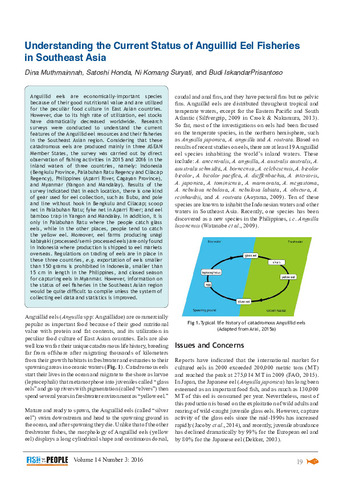Understanding the current status of anguillid eel fisheries in Southeast Asia
Share
trừu tượng
Anguillideels are economically-important species because of their good nutritional value and are utilized for the peculiar food culture in East Asian countries. However, due to its high rate of utilization, eel stocks have dramatically decreased worldwide. Research surveys were conducted to understand the current features of the Anguillid eel resources and their fisheries in the Southeast Asian region. Considering that these catadromous eels are produced mainly in three ASEAN Member States, the survey was carried out by direct observation of fishing activities in 2015 and 2016 in the inland waters of three countries, namely: Indonesia (Bengkulu Province, Palabuhan Ratu Regency and Cilacap Regency), Philippines (Aparri River, Cagayan Province), and Myanmar (Yangon and Mandalay). Results of the survey indicated that in each location, there is one kind of gear used for eel collection, such as Bubu, and pole and line without hook in Bengkulu and Cilacap; scoop net in Palabuhan Ratu; fyke net in Aparri River; and eel bamboo trap in Yangon and Mandalay. In addition, it is only in Palabuhan Ratu where the people catch glass eels, while in the other places, people tend to catch the yellow eel. Moreover, eel farms producing unagi kabayaki (processed/semi-processed eels) are only found in Indonesia where production is shipped to eel markets overseas. Regulations on trading of eels are in place in these three countries, e.g. exportation of eels smaller than 150 grams is prohibited in Indonesia, smaller than 15 cm in length in the Philippines, and closed season for capturing eels in Myanmar. However, information on the status of eel fisheries in the Southeast Asian region would be quite difficult to compile unless the system of collecting eel data and statistics is improved.
Suggested Citation
Muthmainnah, D., Honda, S., Suryati, N. K., & Prisantoso, B. I. (2016). Understanding the current status of anguillid eel fisheries in Southeast Asia. Fish for the People , 14(3), 19-25. http://hdl.handle.net/20.500.12066/997

